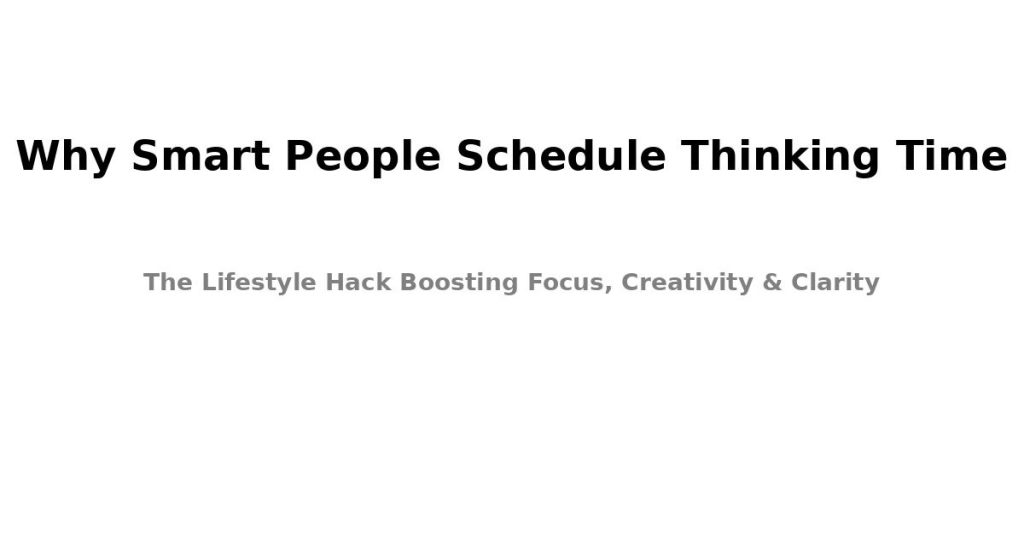In a world obsessed with action, more professionals are embracing a surprising lifestyle trend: scheduling thinking time. From tech executives to creative leaders, blocking off time specifically to think—not do—is quickly becoming the newest high-performance habit.

What Is “Thinking Time” and Why Now?
Scheduling thinking time means deliberately setting aside quiet, uninterrupted periods in your calendar solely for reflection, problem-solving, and strategic planning. Unlike task-oriented hours, this time isn’t about crossing off to-dos—it’s about deep cognitive work. In 2024, it’s gaining traction thanks to the rise of burnout, decision fatigue, and AI overload, which are pushing people to seek clarity over chaos (Goleman, 2013).
The Hidden Cost of Constant Doing
Our schedules are often packed to the minute, which leads to what psychologists call “attention residue”—the cognitive drag caused by rapidly switching between tasks (Leroy, 2009). This state leaves little room for higher-order thinking, strategic vision, or creative insight. When you’re constantly executing, you’re rarely innovating.
Cal Newport, author of Deep Work, argues that “great insights come from periods of focus, not busyness” (Newport, 2016). And he’s not alone—top CEOs like Jeff Weiner of LinkedIn and former Google execs are well-known advocates of scheduling thinking time regularly into their weeks.
When to Actually Schedule Thinking Time
Scheduling thinking time isn’t just for executives. Anyone seeking to improve their decision-making, creativity, or personal goals can benefit from it. Here’s how to implement it effectively:
1. Schedule During Your Peak Energy
Block thinking time when your cognitive energy is highest—typically in the morning for most people. This is when your brain is least fatigued and most able to engage in abstract reasoning and strategic thought.
2. Use Recurring Calendar Blocks
Make it non-negotiable. Treat this time like a high-stakes meeting. Create a recurring event—30 minutes to an hour, once or twice a week—and protect it from interruptions.
3. Eliminate Distractions
Find a quiet environment. Leave your phone in another room. Turn off notifications. Thinking time must be distraction-free to yield insights.
4. Have a Prompt or Question
Approach your thinking session with a focus. Examples:
- What’s the biggest opportunity I’m missing right now?
- What is a recurring problem I can eliminate entirely?
- What would I do if I started from scratch?
The Unexpected Lifestyle Benefits
Beyond productivity, scheduling thinking time also fosters mental wellness. It lowers stress, enhances emotional regulation, and supports long-term vision alignment.
In fact, a 2022 study from Harvard Business Review found that executives who spent at least 10% of their workweek on reflective thought performed better in strategic decision-making and reported higher job satisfaction (Harvard Business Review, 2022).
Additionally, carving out time for strategic thought empowers people to zoom out and assess whether their actions align with their deeper values—something that’s increasingly vital in today’s purpose-driven culture.
Popular Tools to Help You Start
If you’re new to this idea, here are a few tools and frameworks to support your first thinking sessions:
- The Eisenhower Matrix: Use your time to categorize tasks by urgency and importance.
- Mind Mapping Apps (like XMind or MindNode): Helpful for brainstorming complex ideas visually.
- Journaling Prompts: Tools like “The Five Minute Journal” can guide your thinking with minimal structure.
Common Mistakes to Avoid
- Multitasking During Thinking Time: This defeats the purpose. Don’t check emails or sneak in admin tasks.
- Making It Too Long: Start small. Even 15 minutes can be transformative.
- Lack of Intent: Go in with a clear intention. Ambiguity can turn into distraction.
Why This Trend Isn’t Going Away
As remote work continues and work-life boundaries blur, mental clarity is becoming a premium asset. Scheduling thinking time is how high performers stay ahead—not by doing more, but by thinking better.
As productivity expert David Allen said, “You can do anything, but not everything.” Thinking time helps you choose the right “anything.”g, but not everything.” Thinking time helps you choose the right “anything.”
References
- Goleman, D. (2013) Focus: The Hidden Driver of Excellence. New York: Harper. Available at: https://www.harpercollins.com (Accessed: 30 June 2025).
- Leroy, S. (2009) ‘Why Is It So Hard to Do My Work?’, Organizational Behavior and Human Decision Processes, 109(2), pp. 168–181. Available at: https://www.sciencedirect.com (Accessed: 30 June 2025).
- Newport, C. (2016) Deep Work: Rules for Focused Success in a Distracted World. New York: Grand Central Publishing. Available at: https://www.hachettebookgroup.com (Accessed: 30 June 2025).






